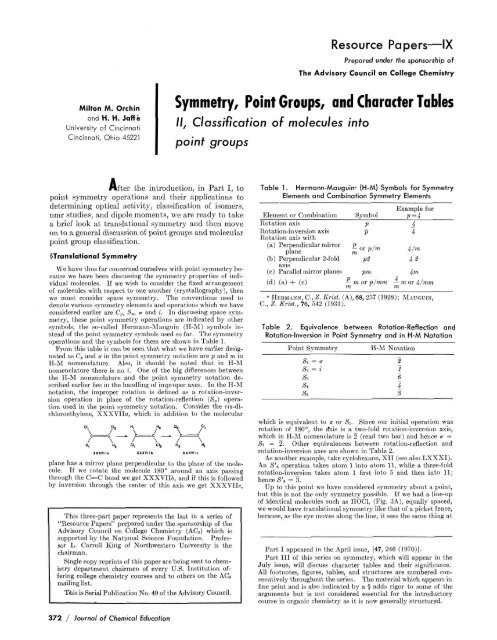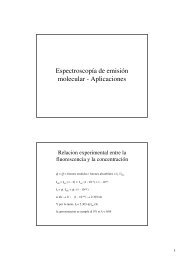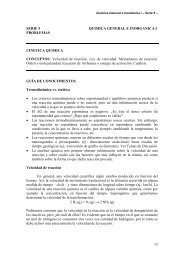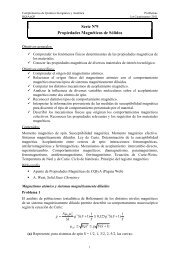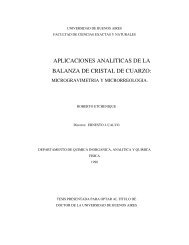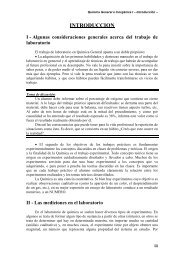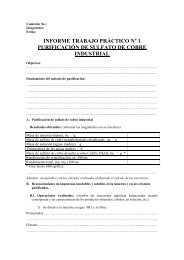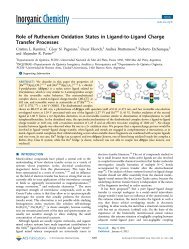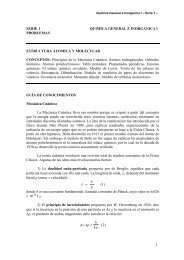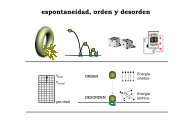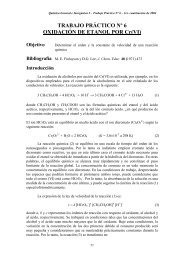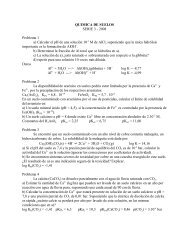Symmetry, Point Groups, and Character Tables 11, Classification of ...
Symmetry, Point Groups, and Character Tables 11, Classification of ...
Symmetry, Point Groups, and Character Tables 11, Classification of ...
You also want an ePaper? Increase the reach of your titles
YUMPU automatically turns print PDFs into web optimized ePapers that Google loves.
Resource Pa pers-IX<br />
Prepared under the sponsorship <strong>of</strong><br />
The Advisory Council on College Chemistry<br />
Milton M. Orchin<br />
ond H. H. Jaffe<br />
University <strong>of</strong> Cincinnati<br />
Cincinnati, Ohio 45221<br />
<strong>Symmetry</strong>, <strong>Point</strong> <strong>Groups</strong>, <strong>and</strong> <strong>Character</strong> <strong>Tables</strong><br />
<strong>11</strong>, <strong>Classification</strong> <strong>of</strong> molecules into<br />
point groups<br />
After the introduction, in part I, to<br />
point symmetry operations <strong>and</strong> their applications to<br />
determining optical activity, classificat,ion <strong>of</strong> isomers,<br />
nmr studies, <strong>and</strong> dipole moments, we are ready to take<br />
a brief look at translational symmetry <strong>and</strong> then move<br />
on to a general discussion <strong>of</strong> point groups <strong>and</strong> molecular<br />
point group classification.<br />
§Translational <strong>Symmetry</strong><br />
We have thus far concerned ourselves with point symmetry hecause<br />
we have been discussing the symmetry properties <strong>of</strong> individual<br />
molecules. If we wish to consider the fixed arrangement<br />
<strong>of</strong> molecules with respect to one another (crystallography), then<br />
we must consider space symmetry. The conventions used to<br />
denote various symmetry elements <strong>and</strong> operations which we have<br />
considered earlier are C,, S,, <strong>and</strong> i. In discussing space symmetry,<br />
these point symmetry operations are indicated by other<br />
symbols, the so-called ITermann-Mauguin (H-M) symbols instead<br />
<strong>of</strong> the point symmetry symbols used so far. The symmetry<br />
operations a.nd the symbols for them are shown in Table 1.<br />
From this table it can be seen that what we have earlier designated<br />
as C, <strong>and</strong> c in the paint symmetry notation are p <strong>and</strong> m in<br />
H-M nomenclature. Also, it should he noted that in H-M<br />
nomenclature there is no i. One <strong>of</strong> the big differences hetween<br />
the H-M nomenclature aud the point symmetry notation described<br />
ezrlier lies in the h<strong>and</strong>ling <strong>of</strong> improper axes. In t,he H-M<br />
notat,ian. . the imnroner .~ .~ rotation is defined ss a rotation-inver-<br />
~<br />
nper%~iun in plwe irf the rl,lalit,lr-r~crtint~ S, trpcl.nrim<br />
$MYI in the point s\.nisne
iCI<br />
Figure 3. A, Translational symmetry. B, Behavior <strong>of</strong> a mirror plane<br />
under translational symmetry. C, Molecular arrangement showing o glide<br />
line.<br />
equal intervals. In this case there is no other symmetry present<br />
besides translational symmetry. If the molecule, e.g., H1O, subjected<br />
to the trsnslation has alredv a mirror ulane normal to the<br />
direction <strong>of</strong> trsnslation (shown as a solid k i n the first section<br />
<strong>of</strong> Fig. 3B), this mirror plane is, <strong>of</strong> course, repeated by the translation,<br />
as indicated by the dashed lines through the oxygens in<br />
Figure 3B. However, the translational operation creates a. new<br />
set <strong>of</strong> mirror planes, at half the translationel distance, which are<br />
shown as long dashed lines. Translation cen also he combined<br />
with a reflection across the translation, as in Figure 3C. Here,<br />
pure translation generates the alternate, equally-oriented molecules,<br />
while the reflection, coupled with trenslstion by onehalf<br />
the repeat distance, generates the molecules <strong>of</strong> the other orientation.<br />
The operation <strong>of</strong> translation plus reflection to give the copy<br />
<strong>of</strong> the original is cdled the glide translation; it is necessarily half<br />
the true translation. In onedimensional symmetry symbolism<br />
this is called g for glide line.<br />
We have thus far in this section discussed translational symmetry<br />
in one direction. A second, non-parallel translation vector<br />
may bedded to the fist to generate 8. pattern which fills a plane.<br />
Finally, the translation can also be made in a direction perpendicular<br />
to the plane, <strong>and</strong> one would then be concerned with many<br />
real situations dealing with space symmetry <strong>and</strong> crystallography.<br />
We will not take these subjects up again, but it is helpful to<br />
realize the irn~r.rlsnr rrlrtirm.~hip bctwccr. pollll +)mrnc,ry,<br />
~~wful in the cuuicler~titn. <strong>of</strong> iillgle molcr.llcs, xnd
whereupon the z-axis is now actually vertical, <strong>and</strong> oh is<br />
actually horizontal.<br />
(b) If the molecule has several rotational axes, the one <strong>of</strong><br />
highest order is taken as t.he vertical <strong>and</strong> z-axis. Thus,<br />
[PtC1412- hes a 4-fold axis <strong>and</strong> four 2-fold axes, two <strong>of</strong><br />
them coincident with the coordinate axes directed at<br />
corners, <strong>and</strong> the ot,her two bisecting opposite sides <strong>of</strong> the<br />
square, XLI. Accordingly, the Cfold axis in the plane <strong>of</strong><br />
XLIV. Hence, in these molecules if the z-axis is placed<br />
vertical <strong>and</strong> the molecule is drawn in the plane <strong>of</strong> the<br />
paper, the x-axis is the axis perpendicular to the paper.<br />
(h) If the molecule is plmar <strong>and</strong> the z-axis is perpendiculer to<br />
lhis plane, the x-axis (which together with the p-axxis must<br />
lie in the molecular plane) is chosen to pass through the<br />
largest number <strong>of</strong> atoms. Thus, in trans-dichloroethylene,<br />
XLb, the z-axis passes through the carbon atoms, <strong>and</strong> in<br />
benzene, XLII, it passes through opposite carbon atoms.<br />
With [PtCld2- the choices me equivalent <strong>and</strong> hence the<br />
assignment is srbitrary.<br />
"L8 XLlL<br />
the paper is t,he z-axis, since the molecule is shown oriented<br />
such that it,s molecular plane is perpendicular to the<br />
plane <strong>of</strong> the paper. The molecular plane is perpendicular<br />
to the vertical C, axis <strong>and</strong> hence is horisontal, irh. Benzene<br />
hes a six-fold axis, s threefold <strong>and</strong> a two-fold axis coincident<br />
with it, <strong>and</strong> six two-fold axes, three bisecting<br />
opposite bonds <strong>and</strong> three passing through opposite atoms.<br />
If the benzene molecule is placed in the plane <strong>of</strong> the paper,<br />
the z-axis is perpendicular to it; if it is drawn perpendicular<br />
to t,he plane <strong>of</strong> the paper, XLII, then the z-axis is in<br />
the plane <strong>of</strong> the paper. The molecular plane is on in either<br />
~ ~<br />
case.<br />
(e) If there are several rotational axes <strong>of</strong> the highest order,<br />
the axis which pa3ses through the greatest number <strong>of</strong><br />
atoms is taken as the z-axis. Thus, in ethylene, XLIIIa,<br />
@O/ ,j-,<br />
XL,"<br />
where there are three equal two-fold axes, the z-axis, the<br />
vertical axis, is taken as the one which is coincident with<br />
the C-C bond. If one wishes to have the z-axis actually<br />
vertical, then the molecule is rotated 90' around the<br />
z-axis, XLIIIb. Naphthalene, XLIV, has three CI axes;<br />
the one passing t,hrough t,he bridging csrhon atoms is considered<br />
to be the z-axis. The three two-fold axes in both<br />
nmhthalene <strong>and</strong> ethvlene are coincident with the z-, y-<br />
<strong>and</strong> z-axes.<br />
Many molecules which have a Cn also have an SX,<br />
(P > 1) coincident with the C,. In such cases, there is no<br />
problem. Thus, chair cyclohexane, XLV, has 6 <strong>and</strong> Ss<br />
It* X,",~ XW,b<br />
coincident, <strong>and</strong> thin is tsken as the z-axis. However, in<br />
tetrahedral molecules, for example, fhere are Ca axes, the<br />
axes which include the C-H bonds, XLVIa, as well as S,<br />
axes, the axes which bisect the A-C-I1 bond angles. In<br />
such cases, it is convenient <strong>and</strong> cust,omary to take one <strong>of</strong><br />
the equivalent & axes as t,he z-axis, XLVIb; this is the<br />
axis which pa3ses through opposite faces <strong>of</strong> the cube in<br />
which the tet,rahedron may be inscribed.<br />
3. The assignment <strong>of</strong> the x-axis is made as follows<br />
(a) If the molecule is planar <strong>and</strong> the z-axis lies in this plane,<br />
the z-axis is chosen t,o be normal to this plane. This is the<br />
situation in water <strong>and</strong> phenanthrene, XXXVIII <strong>and</strong><br />
XXXIX, <strong>and</strong> ethylene <strong>and</strong> naphthalene, XLIII <strong>and</strong><br />
' In the point group DI~<br />
(vide infra), where there are three twotold<br />
rotational axes <strong>and</strong> two olanes <strong>of</strong> svmmetrv, ..<br />
the axis in which<br />
the two planes <strong>of</strong> symmetry intersect is chosen as tho z-axis<br />
Finally, a word must he said about the assignment <strong>of</strong><br />
the positive direction <strong>of</strong> the axes. The convention<br />
usually adopted is the so-called right-h<strong>and</strong> rule. The<br />
thumh, index, <strong>and</strong> middle fingers <strong>of</strong> the right h<strong>and</strong> are<br />
extended in three mutually perpendicular directions.<br />
The directions in which the thumh, index, <strong>and</strong> middle<br />
fingers - are uointina - then become, res~ectivelv, the uositive<br />
x, y, <strong>and</strong> z directions. he ciordina& systems<br />
shown with XXXVIII-XLIV obey the right-h<strong>and</strong> rule<br />
convention; the head <strong>of</strong> the arrow indicates the positive<br />
direction.<br />
Despite the general acceptance <strong>of</strong> the above rules, it<br />
is essential for an author to explicitly indicate his assignment<br />
<strong>of</strong> the coordinate system for the molecule under<br />
discussion.<br />
Assignment <strong>of</strong> <strong>Point</strong> <strong>Groups</strong><br />
Every molecule can he characterized by the symmetry<br />
operations that can be performed on it. If precisely<br />
the same operations can be performed on two<br />
molecules, the molecules, no matter how different<br />
chemically, are symmetry-related <strong>and</strong> must be classified<br />
together.<br />
We have already indicated that H20, XXXVIII, <strong>and</strong><br />
phenanthrene, XXXIX, possess the same elements <strong>of</strong><br />
symmetry, <strong>and</strong> we can perform the following (<strong>and</strong> only<br />
these) symmetry operations on them: Cz', a., <strong>and</strong> a,,.<br />
In addition, the identity oueration, I, can be ~erformed<br />
" -<br />
Properties <strong>of</strong> o Group<br />
. .<br />
on every molecule, <strong>and</strong> hence there are four symmetry<br />
operations that can be performed. The four operations<br />
together constitute a group <strong>and</strong> because each <strong>of</strong> the<br />
operations leaves the center <strong>of</strong> gravity unchanged, the<br />
group is called a point group. The four operations or<br />
elements constituting the group must satisfy the mathematical<br />
properties <strong>of</strong> a group.<br />
For our purposes, the most important requirement<br />
for a set <strong>of</strong> symmetry operations to properly constitute<br />
a group is the requirement that if two operations in the<br />
group are multiplied together, the product must also he<br />
an element (operation) in the group. Let us test this<br />
requirement against the four symmetry operations constituting<br />
the group to which water <strong>and</strong> phenanthrene<br />
belong, using the coordinate system shown with<br />
XXXIX. Let us first note that the operation C1'<br />
changes a point x, y, z to -x, -y, z; a, changes a<br />
point x, y, z to -x, y, z; UZ, changes a point x, y, z to<br />
x, -y, z; <strong>and</strong> finally, the operation I changes a point<br />
x, y, z to x, y, z, i.e., it leaves the point unchanged. Now<br />
if I, C2', azl, uY. constitute the elements in the group,<br />
multiplication <strong>of</strong> any two must give a third. In performing<br />
multiplications <strong>of</strong> symmetry operations it<br />
should he borne in mind that each operation is a mathe-<br />
374 / lournol <strong>of</strong> Chemicol Education
matical operator, not a quantity. The operation is an<br />
instruction to do something; C2' says "rotate 180"<br />
round the z-axis"; u, says "reflect every point in the<br />
molecule through the vertical planc xz," etc. The operation<br />
requires us to operate on an oper<strong>and</strong>, which is<br />
written to the right <strong>of</strong> the operation. Thus, when forming<br />
a product, the elements are taken from right to left;<br />
Czz X UZ, means first to reflect on u,, then to rotate<br />
lSOo around the z-axis. Let us now take any point, x,<br />
y, z; u,, gives x, -y, z <strong>and</strong> the C2' converts x, -y, z to<br />
-x, y, z. Now the conversion <strong>of</strong> x, y, z to -x, y, z by<br />
CnE X UZ, is exactly equivalent to a third operation in<br />
the group, uv,, since u,, also takes the original x, y, z<br />
into -x, y, z; hence, C2V US, = o,. If we wish to<br />
make use <strong>of</strong> our atoms in the water molecule, XXXVIII,<br />
we can focus on a point on the front part <strong>of</strong> the left<br />
hydrogen atom: a, takes the point to the front <strong>of</strong> the<br />
right H atom; Czl takes the point to the rear <strong>of</strong> the left<br />
H atom, where we expect to find the point if the original<br />
point on the front <strong>of</strong> the left H atom is reflected<br />
through 9,. The necessity for including the operation<br />
I in a point group is now clear. In the present point<br />
group the square <strong>of</strong> every element gives the original:<br />
CsV C2' = I, etc.<br />
$ We indicated above that there are other formal mathematical<br />
requirements for s set <strong>of</strong> elements to constitute a. group. These<br />
other requirements are<br />
1. There is an element I such that <strong>11</strong>.1 = X.1 = X. I is the<br />
identity operation <strong>and</strong> Xis my operation in the set.<br />
2. The associative law holds, i.e., abc = (ab)(c) = a(bc). (The<br />
commutative law: ab = ba, does not always hold in groups.<br />
In theease <strong>of</strong> water above, the four elements do commute <strong>and</strong><br />
in such cases the group is said to he Abelian.) All point. groups<br />
that do not have an ares higher t,han two-fold are Ahelian.<br />
3. For each element, X, there must he another element which is<br />
its inverse, Y = X-1 such that YX = I. The inverse operation<br />
was aescrihed earlier. In the present example <strong>of</strong> water,<br />
each element is its own inverse, e.g., 180' rotation around the<br />
z-axis in either direction followed by 180" rotation in the<br />
opposite direction returns the molecule to the orientstion<br />
identical with the original.<br />
<strong>Classification</strong> <strong>of</strong> <strong>Point</strong> <strong>Groups</strong><br />
In our classification scheme we will start with point<br />
groupsJ that have the least symmetry <strong>and</strong> finish with<br />
those point groups which characterize molecules <strong>of</strong> the<br />
highest symmetry. It is convenient for such classification<br />
to use the rotational axis (axes) as the principal<br />
criterion <strong>of</strong> classification.<br />
Type I: No rotational axis greater than one-fold:<br />
Poznt groups C,, C,, Ci (See XLVII-LI).<br />
(a) CI. This point group has no elements <strong>of</strong> symmetry, <strong>and</strong><br />
hence all compounds which belong to this point group are<br />
symmetric.<br />
(h) C,. This group has only a single plane <strong>of</strong> symmetry, o (which<br />
as we showed earlier is equivalent to St).<br />
(c) C;. This group has only a center <strong>of</strong> inversion (which is<br />
equivalent to A).<br />
Type II: Only one axis <strong>of</strong> rotation greater than one-fold:<br />
<strong>Point</strong> groups C,, S,, C,,, Cph.<br />
(a) C,. Molecules in these point groups (LII-LIV) have only a<br />
smgle rotational axis <strong>and</strong> all such molecules are necessarily<br />
dissymmetric <strong>and</strong> hence optically acl.ive. If 1,2-dichloraethane<br />
were fixed in the eonform.ztion show" in IXb, it would<br />
belong to this point, group.<br />
,,,- LIIb , 8 8 8 LC"<br />
(h) 8;. There are only a few known molecules thst belong t,o<br />
these point. groups. A molecule with S4 har also C2 <strong>and</strong> one<br />
with &has Ca, hot if these are the only symmetry elements<br />
prosent, the point groups are & <strong>and</strong> SI. Of special interest is<br />
the molecule ~hown in Figure 2, which belongs to & <strong>and</strong><br />
which war synthesized explicitly to test for optical activity;<br />
the molecule is inactive because the & axis assures that its<br />
mirror imqe is superimposahle.<br />
(c) CnO. M~lecules belonging to ihese point groups have the<br />
symmetry elements C, <strong>and</strong> p vertical planes (s,) int,ersecting<br />
in the axis. We have already described in detail the molecules<br />
H.0 <strong>and</strong> phenanthrene which belong to C*,. Molecules<br />
in the point groups C,. are very common <strong>and</strong> same are shown<br />
in LV-LXIII. A suecia1 case is a = rn which is the uoint<br />
group <strong>of</strong> all linear molecules which do not have a center <strong>of</strong><br />
symqetry, e.g., heteronuclear diatomic molecules.<br />
(d) Cgh. molecule^ belonging to such point groups have the<br />
symmetry element C, <strong>and</strong> at right angles to this vertical axis<br />
a mirror or horizontal plane m. Since C, X ah = Ssr they<br />
also have S,. When p is an even number, the presence <strong>of</strong> r~<br />
implies i. Some examples are shown in LXIV-LXVI.<br />
li<br />
ci<br />
Type <strong>11</strong>1: One p-fold axis <strong>and</strong>, p two-fold axes perpendicular<br />
to the principal axis: <strong>Point</strong> groups D,, D,,, <strong>and</strong><br />
DM.<br />
The symbols for the symmetry point groups thst are used<br />
here are the so-called Schoenflies symbols, named after their inventor.<br />
The alternate notation, which is used to describe space<br />
symmetry groups is the Hermann-Msuguin notation.<br />
Volume 47, Number 5, May 1970 / 375
(a) Dll. If, to the principal axis C,, are added p two-fold axes ns<br />
the only symmehry elements, the molecule belongs to the<br />
point gronp D,. This is not a common point group <strong>and</strong> Da is<br />
encountered more frequently than other D, point groups.<br />
hIoleoules belonging to Dn normally have two equivalent<br />
halves twisted with respect to each other at an angle greater<br />
than zero <strong>and</strong> less than 90'. Thus, twisted ethylene <strong>and</strong><br />
twisted biphenyl belong t,o D2. The Newman projection <strong>of</strong><br />
twisted ethylene is shown in LXVII. The principal or vertical<br />
axis is the carbon-carbon bond axis <strong>and</strong> the two two-fold<br />
axes are in a. plme perpendicular to this axis <strong>and</strong> are perpendicular<br />
to each other. They are shown as broken Lines.<br />
iu splane horizontal to the major axis <strong>and</strong> me perpendicular to<br />
each other. These two two-fold axes bisect t,he angles between<br />
the planes <strong>of</strong> symmetry; they are difficult to see without<br />
a model bot are shown as broken Lines in the bottom diagram<br />
beside LXXIX which is a top view <strong>of</strong> the diagram<br />
above it. Now, since it is the Cz axes which are the frame <strong>of</strong><br />
reference, the planes are considered to bisect the angles belween<br />
the axes, <strong>and</strong> the Cr axes are the coordinate axes.<br />
Thus, the plenes <strong>of</strong> symmetry become diagonal with reference<br />
to the C2 axes <strong>and</strong> hence the designation Dad, where d st<strong>and</strong>s<br />
for diagonal planes <strong>of</strong> symmetry. Completely staggered<br />
ethane, LXXX, belongs to Dad. Here the principal axis is<br />
C3 <strong>and</strong> includes the carbon-carbon bond. At right angles to<br />
this axis are three C1 axes shown as broken lines in the Newman<br />
project,ion formula. The three plenes <strong>of</strong> symmetry,<br />
ud, bisect the angles between mecessive tw<strong>of</strong>old axes. Chair<br />
cyclohexane, LXXXI, has vertical C. axis, 3C9 axes at right<br />
angles which bisect opposite carbon-carbon bonds <strong>and</strong> 3ad<br />
which pass through opposite carbon atoms. Ferrocene, in<br />
the staggered conformation, LXXXIIa, belongs to point<br />
group Dad, which point group is eh~racterised by one five-<br />
(h) D,n. If eh i~ added to D, the molecules having C,, p two-fold<br />
axes, <strong>and</strong> s. mirror plane perpendicoler to the principal axk<br />
(C,) belong to DPh; these symmetry elements imply, in addition,<br />
p vertical planes, PC,. Many molecules belong to this<br />
point group, especially to Dnr. In Dm we find one two-fold<br />
axis <strong>and</strong> a mirror plane perpendicular to this axis which also<br />
contains two bwo-fold axes. In Dlh all three axes %re CI so no<br />
one axis st<strong>and</strong>s out ar the principal axis. The principal or<br />
vertical axis is arbitrarily chosen as the one (in the molecular<br />
plane if one exists) which passes through the largest number<br />
<strong>of</strong> atoms. Examples <strong>of</strong> Dph molecules are shown in LXVIII-<br />
LXXVI. Thus, benzene has s Cs axis (thevertical axis) <strong>and</strong><br />
in the symmetry plane whieh is the molecular plane <strong>and</strong><br />
which is at right angles to the C. axis, there are six two-fold<br />
axes: three which pass 1,hraagh opposit,e.osrbon atom <strong>and</strong><br />
three which bisect opposite bonds. If p is even, i is present.<br />
A special case is p = m, giving Dm+,, which is the point group<br />
to which all linear molecules with a center <strong>of</strong> symmetry helone:<br />
- homonuclear diatomies; carbon dioxide; acetylene;<br />
etc.<br />
(c) Dpd. Molecnles in these point groups, in addition to having<br />
the axes defining D,, have p diagonal planes, od, which bisect<br />
the angles between successive two-fold axes. Also, because<br />
S, X C2 = SzD, they have 2p-fold alternating axes. In Du<br />
there are normally two equivalent halves <strong>of</strong> a. molecule<br />
t,wisted exactly 90° with respect to one another. The spiran<br />
shown in LXXVII; allene, LXXVIII; <strong>and</strong> biphenyl twisted<br />
exactly 90°, LXXIX, are examples. Actually, in these mole-<br />
fold principal <strong>and</strong> vertical %xis, five two-fold axes at right<br />
angles to it <strong>and</strong> five diagonal planes <strong>of</strong> symmetry. The view<br />
looking down on the moleoule is shown in LXXXIIb. The<br />
heavy lines show the five od; the five two-fold axes bisect the<br />
angles between these planes. This view is particularly favorable<br />
for recognizing the presence <strong>of</strong> Sio which must be present<br />
because in Dja there must be &, = Sm<br />
Type IV: More than one axis higher than two-fold:<br />
Poznt groups T, <strong>and</strong> 0, <strong>and</strong> also T, T,, 0, I, I, <strong>and</strong> K,.<br />
(a) Ta Tetrahedral molecules with identical atoms or groups <strong>of</strong><br />
atoms around 8. central atom belong to this point group.<br />
Some common molecules are methane, carbon tetrachloride,<br />
<strong>and</strong> nickel tetracarbonyl. The symmetry properties <strong>of</strong> point<br />
group Td are more readily recognized when the molecule is<br />
inscribed in acube such as shown for methaneinXLVIh. The<br />
symmetry elements present are 4C3, 3Ca (which coincide with<br />
3&) <strong>and</strong> 60. The axis through a corner <strong>and</strong> opposite face is a<br />
CJ axis, <strong>and</strong> since there are four corners, there are 4C3. These<br />
4Ca symmetry axes permit 8Ca operations, since in the case<br />
<strong>of</strong> s. Ca axis the clockwise <strong>and</strong> counterclockwise rotations give<br />
equivalent but not ldenticd orientations. The 3C2 symmetry<br />
axes <strong>and</strong> the 3& axes coincident wlth them give rise to 3Cs<br />
<strong>and</strong> 6S4 operations. The axes through the midpoints <strong>of</strong><br />
opposite edges are the C* axes, <strong>and</strong> since there are six edges,<br />
there are 3CI. Each edge lies in one mirror plme, <strong>and</strong> since<br />
there are six edges, there are 6.r. Organic molecules <strong>of</strong> the<br />
high symmetry required for Td %re not common (adamantsne<br />
is one) hut there are many examples <strong>of</strong> inorganic molecules<br />
(especially <strong>of</strong> silicon <strong>and</strong> tetracoordinsted aluminum) with<br />
this symmetry.<br />
(b) Oh. All symmetrical octahedral compounds belong to this<br />
point group, as do the cube <strong>and</strong> the octahedron. Octahedral<br />
molecules are fairly common in inorganic chemistry; some<br />
examples are shown in LXXXIV <strong>and</strong> LXXXV. The sym-<br />
cdes it is usually easier to recognize the planes <strong>of</strong> symmetry<br />
than the C, axes perpendicular to the vertical axes. Each <strong>of</strong><br />
the molecules in LXXVII-LXXIX has two planes <strong>of</strong> symmetry,<br />
the one in the plane <strong>of</strong> the paper <strong>and</strong> a plane perpendicular<br />
to the plane <strong>of</strong> the paper. The principal CV axis coincides<br />
with the intersection <strong>of</strong> these two planes. The two C1<br />
axes, which together wi1.h the principal CZ axis define Dn, are
metry elements which characterize this point group <strong>and</strong><br />
which are perhaps most readily recognized in the octahedron<br />
itself are 6C4 (operations 3C4 <strong>and</strong> 3C:); 8Cs (operations 4C8<br />
<strong>and</strong> 4C'a); 9C2 (<strong>of</strong> which three are coincident with C4); i;<br />
<strong>and</strong> 90. The C, axes psss through the opposite corners <strong>of</strong><br />
the octahedron (six faces, hence 3C4 axes). The Ca axes pass<br />
through pairs <strong>of</strong> opposite faces <strong>and</strong> the center <strong>of</strong> the octshedron<br />
(eight faces, hence 4Ca axes). The C2 bisects pairs <strong>of</strong><br />
opposite edges (twelve edges, hence 6C2; the three C, axes<br />
are also CI axes). There are two sets <strong>of</strong> mirror planes-one<br />
set goes through the centers <strong>of</strong> four faces <strong>and</strong> two edges (one<br />
set <strong>of</strong> six ea) <strong>and</strong> the other set consists <strong>of</strong> three wt, each <strong>of</strong><br />
which is defined by four edges, for a total <strong>of</strong> 9 ~ . All 9v transform<br />
in the same way <strong>and</strong> belong to the same class. The<br />
other point groups belonging to typeIV are <strong>of</strong> less importance<br />
because only a few molecules belong to them. A boron compound<br />
with the symmetry <strong>of</strong> an icosahedron (In) har been<br />
reported. Such a geometry involves 20 faces that are equilateral<br />
triangles, snd the point group In to which it belongs<br />
has 120 symmetry operations.<br />
(e) Kn. This point group characterizes the sphere, the geometry<br />
possessed by dl free atoms. All possible symmetry elements<br />
belong to this point group.<br />
A Convenienf Procedure for Assigning the Poinf Group<br />
<strong>of</strong> o Molecule<br />
We shall now describe a quick method for classification<br />
<strong>of</strong> molecules into point groups based on their symmetry<br />
properties. This method will probably take care<br />
<strong>of</strong> most <strong>of</strong> the molecules that need to be classified.<br />
(1) If a molecule is linear, it belongs to point group C, if it does<br />
not have s. horizontal plane <strong>of</strong> symmetry (e.g., HC1) <strong>and</strong> to<br />
point group Dmh if it does (acetylene).<br />
(2) If the molecule is tetrahedral it belongs to Ts (methane), <strong>and</strong><br />
if octahedral, On (chromium hexecarbonyl).<br />
(3) If the molecule has only one axis which is two-fold or higher<br />
(C, p > 2), look for p two-fold axes at right angles to the C,<br />
8x1s. If these exist, the molecule belongs to one <strong>of</strong> the D<br />
groups. If there is a horizontal plane, the molecule is Dnh<br />
(PtCL, Dl*). If there is no horizontal plane hut p vertical<br />
planes, the molecule belongs to D,s (staggered ethane). If<br />
there me no planes, it is D,. In the special but common case<br />
where the molecule has three C2 axes ail at right angles to<br />
each other, the molecule belong to Dnn if it also har three<br />
Figure 4.<br />
44<br />
Special <strong>Groups</strong>*<br />
A Row chart forslarrifying molecular symmetryinto point groups.<br />
planes <strong>of</strong> symmetry (ethylene), <strong>and</strong> to DW if the molecule has<br />
two equal halves twisted 90' with respect to each other<br />
(ailene). Three (2% axes <strong>and</strong> no planes is D*.<br />
(4) If the molecule has only a rotational axis, C,, p > 2, the<br />
molecule helongs to point group C, (trans-1,2-dichlorocyc10-<br />
propane, CI). If in addition to 8 single C. axis there is one<br />
horizontal plane (<strong>of</strong>ten the moleculm plane), the molecule<br />
belongs to C-A (trans-dichloroethylene, CSA). If there is no<br />
horizontal plane hut p vertical planes, the molecule belongs<br />
to C,. (ammonia, Ca.).<br />
(5) If there is no rotational axis (other than the infinite number<br />
<strong>of</strong> CI axes) but the molecule has a plane <strong>of</strong> symmetry, it belongs<br />
to C.; if it has only a center <strong>of</strong> symmetry, Ci; <strong>and</strong> if it<br />
is truly asymmetric, it belongs to Ci.<br />
A systemat.ic flow chart arrangement for classification<br />
is shown in Figure 4.<br />
Volume 47, Number 5, May 1970 / 377


